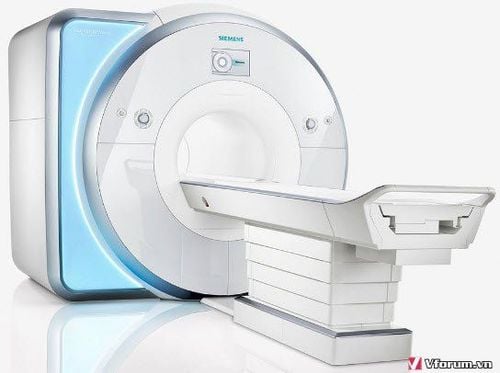This is an automatically translated article.
Laryngeal cancer is more common in people over 60 years of age and is more common in men than women. Surgery is one of the main treatments in laryngeal cancer. Your doctor may recommend removal of part or all of your larynx depending on the location, size of the tumor, and the severity of the disease.
1. What is laryngeal cancer?
The larynx is located in the throat, between the back of the tongue and the windpipe. The larynx consists of three main regions: the epiglottis, the glottis, and the subglottis. The larynx has several functions including helping to form voice or sounds from the vocal cords, preventing food or drink from entering the lungs when swallowed by closing the epiglottis, allowing inhaled air to reach the lungs.
Laryngeal cancer is the formation of malignant tumors inside the larynx. Usually, laryngeal cancer begins in the glottis. The most common form of laryngeal cancer is squamous cell cancer. There are also several other types including squamous cell carcinoma, rhabdoid carcinoma and basal squamous cell carcinoma, adenocarcinoma, etc. Symptoms of laryngeal cancer are traction hoarseness. longer than 3 weeks, voice changes, pain when swallowing or trouble swallowing, lump or swelling in the neck, persistent cough, sore throat, trouble breathing, bad breath, or unintentional weight loss.
2. Partial or total resection when treating laryngeal cancer?
Surgery is one of the main treatments for laryngeal cancer. The goal of surgery is to leave as much of the larynx intact and preserve as much speech as possible (since a total laryngectomy renders the patient unable to speak). The surgical procedure will depend on many factors, including the size, location of the tumor, and the patient's overall health. There are several types of laryngectomy, including:
Total laryngectomy : The entire larynx is removed. When a patient has a laryngectomy, the trachea and esophagus (food pipe) become disconnected, causing changes in breathing and swallowing after surgery. To breathe, a stoma is opened in the neck, in front of the windpipe. This procedure may require removal of part of the pharynx (the tubular structure that connects the nose, larynx, and lungs), some lymph nodes, and some nearby muscles. After total laryngectomy, the patient will lose the ability to speak. The surgeon may perform a perforation of the esophagus or place a hole in both the trachea and esophagus, for future laryngotracheal placement. Partial laryngectomy: Having laryngeal cancer does not necessarily require removal of the entire larynx. There are many cases where the tumor can be removed without having to remove the entire larynx. In this procedure, the doctor removes the tumor and part of the larynx. A temporary tracheostomy may be performed and may later be removed. Partial resection of the larynx allows the patient to preserve the voice.
3. What are the risks associated with laryngectomy?
There are risks and side effects associated with laryngectomy, including:
Reactions to anesthesia. Possible reactions include wheezing, rash, and hypotension Bleeding. A blood clot occurs. Infection. Pneumonia or other problems in the heart or lungs. Voice loss or voice changes Nerve damage. Swelling Shortness of breath: Although some techniques may require temporary tracheostomy, with the exception of a nearly total laryngectomy, the patient should be able to breathe spontaneously. Narrowing of the throat or larynx, called dysphagia, can lead to the need for a feeding tube. Swallowing is the function that is most affected after surgery, especially in cases where the epiglottis must be removed, because there is a risk of causing food choking (food falls into the respiratory tract). Develop a fistula (abnormal connection between pharynx and skin) and patient may need surgery Damage to nearby organs such as thyroid and parathyroid glands. This can lead to hypothyroidism and/or abnormalities in calcium levels. Other organs that can be damaged are the trachea and esophagus. Congestion
4. Recovery after partial or total laryngectomy
Recovery from laryngectomy will depend on the type of procedure the patient had. Sometimes, patients need to stay in the hospital for a short time for observation. Usually, the patient will need to have a tube inserted to get nutrients until the throat heals. To speed up recovery after laryngectomy, patients should note the following issues:
Avoid heavy lifting and strenuous exercise for 6 weeks. Avoid bending over Perform wound care as directed. Ask your doctor about when you can bathe and how to protect your trachea from getting wet or getting wet. Avoid wearing tight clothing around your neck. Avoid exposure to secondhand smoke and people with respiratory infections. Avoid contact sports. Be sure to take your medication as directed to prevent pain, infection, and constipation. You should change your diet, drink more water, and take over-the-counter medications to limit constipation. Practicing deep breathing and rest can help manage pain and speed up the healing process. Try to do deep breathing and relaxation exercises several times a day. Use a thermometer to monitor your body temperature as this could be a sign of an infection. Buy wound care tools, humidifiers. When having the following abnormal signs, the patient should call the doctor or go to the medical facility immediately:
Swelling, bleeding, blistering, crusting or discharge at the incision site. New or worsening pain. Nausea and vomiting. Change in color and/or consistency of sputum. Difficulty swallowing. Cough, shortness of breath, chest pain and/or any other related symptoms. In summary, patients with laryngeal cancer often have a better prognosis than other cancers due to relatively early detection. Changing the diet, maintaining a healthy lifestyle and stopping alcohol and smoking will significantly improve the prognosis in patients with laryngeal cancer.
To detect early stage laryngeal cancer, you should screen for cancer as soon as there are abnormal signs on the body. Currently, Vinmec International General Hospital is implementing screening services, and early detection of oropharyngeal, hypopharyngeal and laryngeal cancers including:
Full range of necessary services for early detection of oropharyngeal cancer show other abnormalities in the arch - hypopharynx - larynx area When registering for screening service, and early detection of nasopharyngeal, hypopharyngeal, and laryngeal cancer, customers will be screened for nasopharyngeal - hypopharyngeal cancer - larynx through general otolaryngology examination with hard or soft endoscope; Software ultrasound, thereby detecting the disease early, improving the effectiveness of treatment, increasing the survival rate for patients.
Please dial HOTLINE for more information or register for an appointment HERE. Download MyVinmec app to make appointments faster and to manage your bookings easily.
Source: oncolink













